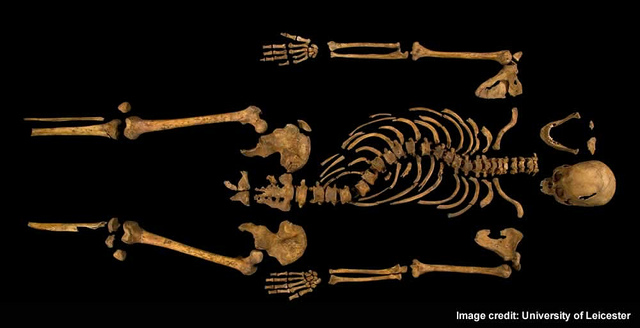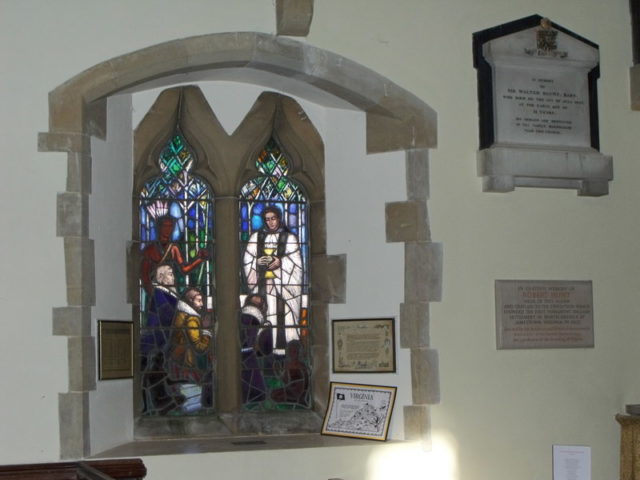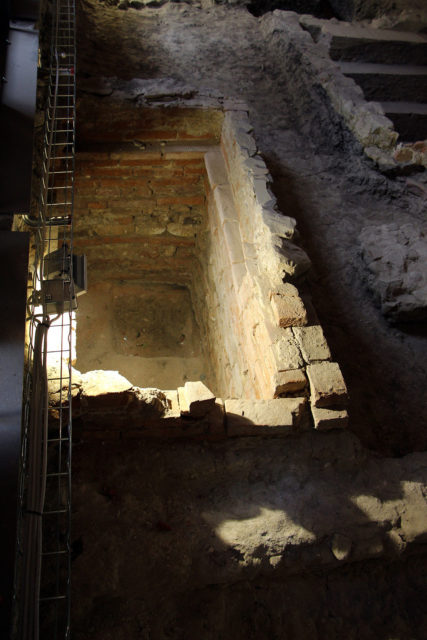Putting names to bones
The art and science of identifying famous people from the past
Meghan Bartels • March 7, 2016

The remains identified by a team of archaeologists as belonging to King Richard III of England. They have since been reinterred. [Image credit: University Leicester | CC BY-NC-ND 2.0]
Since his death in the 1480s, King Richard III of England spent many years in the winter of his discontent, little known beyond his role as one of Shakespeare’s greatest villains. But in early 2013, a team of scientists gave him a glorious summer with a stunning announcement — that they had found his remains under a parking lot in Leicester.
Richard III is just one of many famous figures from history whose grave markers have been lost, but whose remains archaeologists now claim to have found. Last July an American team identified four early colonists at Jamestown, and September brought an update from an Italian excavation seeking Leonardo da Vinci’s model for his famous Mona Lisa.
But the practice gets at one of the core philosophical debates about history: Is it shaped by great individuals or is it the story of the masses? For Neville Morley, a classical historian at the University of Bristol in the U.K., it’s an easy call: History should be about broad societal trends, and celebrity excavations divert resources from the nuts and bolts of archaeology. “This does pander to popular expectations of archaeology and history that it’s about kings and fabulous treasures rather than the careful, critical reconstruction of past societies,” he says.
“This whole thing of digging up celebrities and searching for famous people has been going on for hundreds of years,” says Katy Meyers Emery, who studies and blogs about mortuary archaeology at Michigan State University. But as scientific techniques develop, they complicate the process, making these investigations more expensive but also offering a better chance of an actual answer.
Consider Richard III. A team led by Richard Buckley of the University of Leicester made its announcement after having pulled together what they considered an ironclad case drawing on a broad collection of evidence. The skeleton in question was the very first they’d uncovered at the site, even though “the idea was that we’d never find Richard,” says Turi King, the geneticist for the investigation, “and that it would be about a half a day of my time. That was several years ago!”
The team’s arguments drew both on documents from around the time of the king’s death and on forensic analysis of the skeleton they’d found. Digging in a spot referenced in chronicles written shortly after Richard’s death, they’d found a skeleton marked by traumatic fatal wounds worthy of Richard’s final battle at Bosworth, with Richard’s alleged curved spine, and they had genetic analysis comparing the remains with known living relatives of Richard’s.

A small sign marks the site where remains later identified as Richard III’s were discovered. [Image credit: Chris Tweed | CC BY-SA 2.0]
“I’m very skeptical about putting specific names to samples in this way,” she says. Avila was convinced by the final publication because it included a statistical analysis that combined genetic evidence with the archaeological context of the skeleton. This analysis drew on records of other burials and noted what proportion displayed each identifying characteristic. Multiplying these proportions gave the team an idea of how likely it was that remains would match every factor purely by chance.
“It’s not a case of weighting the evidence,” King says. “It’s a case of going ‘how often do you find this?’” Even without considering genetic evidence, the team calculated that there was just a one in 85,000 chance the bones don’t belong to Richard. Genetic evidence bettered those odds to one in 6.7 million. Scientists across relevant fields now agree that the identification is solid.
That’s true even though the Y chromosome analysis was not a match for the relatives genealogists traced. “I wasn’t remotely surprised about that,” says King, who wrote her dissertation on Y chromosome genetics and last names. “I know that there is a historical false paternity rate, so where the recorded father’s not the biological father, that happens about 1 to 2 percent per generation.”
The strongest piece of supporting genetic evidence is the analysis of Richard’s mitochondrial DNA. Each cell of your body contains mitochondria, little cellular power plants contained within their own bubble, but they come to you directly through your mother’s egg. That means that unlike the DNA in your chromosomes, which is a muddle of information from both your parents, mitochondrial DNA is inherited only from your mother.
Usually that wouldn’t necessarily help, since women are difficult to trace through records. But aristocratic families tend to keep careful track of their family histories. That meant genealogists were able to trace two separate branches of the family tree, mother to daughter, from Richard’s sister to two living relatives who were willing to provide samples. Both samples matched the skeleton closely and all three share a flavor of mitochondrial DNA so rare in the UK and Europe that King couldn’t find a single example of it in a database of 28,000 samples.
Most excavations don’t have the luxury of mitochondrial DNA. William Kelso is director of archaeology at the Jamestown Rediscovery Project in Virginia, a project to excavate the first successful British settlement in America, founded in 1607. Last summer he helped announce that four skeletons found at the site of a church in Jamestown belonged to specific early residents of the town.

A chapel window in England commemorates Robert Hunt, a reverend and one of the four Jamestown founders whose remains were identified last summer. [Image credit: Nick MacNeill | CC BY-SA 2.0]
Kelso sees clear scientific value in identifying remains. “It’s opened up all kinds of avenues of new research,” he says. For example, the excavation found a reliquary, a very Catholic item, on top of the coffin identified as belonging to Captain Gabriel Archer. Not only was the church housing the remains Protestant, but historians had believed the town was home exclusively to Protestants, and even that they actively opposed Catholicism. That’s a very different picture of history than would be painted if this early leader were secretly a Catholic, as suggested by the archaeology.
So far, the Jamestown identifications mostly rely on a basic profile of the skeleton’s sex, age and time in the colonies, the last established thanks to the more frequent cavities from the New World’s corn-based diet as compared to Europe’s wheat-based diet. The team took these details, along with archaeological characteristics of the burials themselves, like expensive coffins, and cross-referenced them with records of who was at the colony at the time.
While so far the Jamestown team has not published a statistical analysis like that conducted by the Richard III investigators (Smithsonian researchers are still studying the remains), Kelso echoes the sentiment behind it. “No single fact is particularly the strongest but rather it is the combination of archaeological, forensic and documentary evidence,” he says.
You might think that forensic scientists working with more recent remains have an easier time of it with access to more and fresher physical evidence, often including tissue and DNA. But Sue Black, director of the Centre for Anatomy and Human Identification at the University of Dundee in the U.K., says that identifying remains still relies on documents, never solely the number a fancy machine displays in a lab.
In the modern cases she works on, forensic scientists examine the remains to develop a biological profile, which considers sex, age at death, ancestry and height. Those four factors allow the police to narrow their search to a more manageable number of candidates. Then they can use medical and dental records to actually put a name to the victim.
Similarly, in the case of Richard III, archaeologists carefully selected the location of the excavation based on historical records, were able to link the scoliosis of the skeleton to written descriptions of the king, and traced Richard’s family through documents to find living relatives.
Kelso also believes tying specific individuals to remains makes it easier for people today to connect to history. “It personalizes the story, I think; it enriches it,” he says.
Not only do Kelso and the Jamestown Rediscovery Project stand by the value of searching for the graves of specific individuals, they’re looking to do it again. Over the next couple of years, the team will be excavating a second church site, in hopes of finding the remains of Thomas West, Baron De La Warr, for whom Delaware was named.
He died at sea, but the team has evidence suggesting his remains, previously believed to have been thrown overboard, were actually brought back to the town for burial. Kelso says that if the search is successful, it will underscore the importance of Jamestown at the time, since De La Warr was one of the highest status men in the colony.
Kelso’s sentiment is echoed by Giorgio Gruppioni, a bioarchaeologist based at the University of Bologna in Italy. He has tested remains believed by some to belong to Lisa Gherardini, the likely model for Leonardo da Vinci’s famous Mona Lisa. “The identification of the remains of an individual from the past has above all a symbolic importance,” Gruppioni .

A tomb in the church of St. Ursula in Florence, where bones some believe belong to Leonardo’s model for the Mona Lisa were found. [Image credit: Sailko | CC BY 3.0]
But scientifically, this case may never be proved beyond a doubt. Researchers estimate from radiocarbon dating that the remains date from between 1440 and 1640, which is the right time frame for Lisa Gherardini. But just a partial skeleton has been assembled, which means Gruppioni is missing key bones, like the pelvis to confirm a skeleton’s sex. He only has enough evidence to confirm the remains are of an adult, likely female. And while he knows where to find the remains of Gherardini’s children, those bones are too degraded to provide DNA samples of high enough quality for today’s sequencing techniques.
Those are common forensic issues and don’t necessarily suggest a shabby identification is being made, says Kristina Killgrove, a bioarchaeologist at the University of West Florida. But it’s really the bigger picture that bothers her. “If it’s just sort of a morbid curiosity to see whether this person’s skull matches a painting, that doesn’t really have scientific benefits,” she says. That’s even truer because she and some other archaeologists consider facial reconstruction generally “not very scientific,” since it relies on an artist’s choices as well as characteristics of the remains.
Killgrove is more interested in looking at as many sets of remains as possible to understand what’s happening at a population level, rather than focusing on the elite. “One skeleton can’t tell you everything.”
“The vast majority of people who lived throughout history are not recorded in documentary records,” says Alison Atkin, who studies burials of plague victims in England at the University of Sheffield, “so their stories are often lost.” She notes that the dig that found the remains of Richard III also found several other sets of remains, some of which likely belonged to monks of the Greyfriars order that owned the church. But these remains have received very little attention next to Richard III.
There’s a chance another former king may outshine monks from another religious house. While the current locations of most former English monarchs are known, a handful remain unaccounted for. Henry I, king during the 12th century, was buried in Reading Abbey, which was destroyed during the 16th century. Now, a team is looking to rediscover his remains — which, incredibly, may be under a parking lot, like Richard III’s, or a playground.
If they do find candidate remains, Henry’s identification will play out differently from Richard’s, according to the geneticist who has spent so much time on the latter’s identification. “You hope that they’ve got an awful lot of other circumstantial evidence which helps them identify the remains because the DNA in that case will be quite difficult,” says King. Because Henry lived twice as long ago, genealogists would have to trace twice as many generations to find a living relative to compare samples, an unlikely feat.
Richard’s case isn’t quite tied up yet either. King is finishing her final work with his DNA — publishing his entire genome, online and available to scientists and historians, later this year. “There’s actually huge amounts that we don’t understand about our DNA,” King says, “so as more and more is understood, people will be able to go back and revisit Richard’s genetic data and learn more information about him.”
Even if it does still have secrets to share, Richard’s genome will tell us only about Richard, not about the thousands of his supporters, rivals and subjects whom historians would also like to meet. King admits that freely. But her experience also suggests that people may not care how much these cases drive science. Richard’s fans “come up and shake my hand because it’s the hand that held Richard,” she says. “With gloves on, but you know.”
3 Comments
An interesting article, but a shame that the real reason for the discovery of the remains of Richard III is not mentioned, namely the project initiated by the Looking for Richard team (Philippa Langley, John Ashdown-Hill and colleagues). His remains were not found because of ‘archaeology’ – it was because of a search for the truth about the king and an attempt to restore his reputation. Archaeology was a tool to achieve this, one among many, including the immense amount of prior historical and genealogical research undertaken by the LFR team – before Leicester University and its scientists jumped upon the bandwagon and commandeered the remains that their archaeology unit was commissioned to dig for. ‘Celebrity archaeology’ it wasn’t – the archaeologists concerned were at the time very quick to say that they themselves were searching, not for the king’s remains, but for the site of the Greyfriars, which had been mysteriously lost by Leicester residents since its destruction in the Reformation, but which Dr Ashdown-Hill (drawing on work by a number of other concerned Ricardians and historians) had managed to locate (this was the ‘spot referenced in chronicles written shortly after Richard’s death’ – which no one else had bothered to try to find, least of all the archaeologists who had to be shown where to dig by Philippa and John (remember the much-ridiculed ‘R’ painted in the parking space?), and then paid extra in order to be persuaded eventually to excavate the skeleton more than a week later!)
I was very intrigued by the discovery of the bones of Richard III and the good controversy it has created for the pending rewriting of this period of history. Going through my genealogy at http://www.geni.com ,I took a re-look at my families history toward Richard III … such an eye opener.
Last year, my Cousin and I went for the first time to visit Historic Jamestowne. It was there that were were told about and saw the burial site of the Four early founders. We met Dr. Kelso in our passing, but to our amazement at the main talk, we suspected and later knew our family connections there, when we talked to Dr. Kelso’s assistant, James Horn and found family links that have come together in the echo’s of time. So for us, we felt the benefit providence of how noble and royal such re-discoveries can be.
Rev./Dr. A. Edward Moch++++
My ancestors are the Plantagenets and are traced back to Foulques or Fulk Plantagenet. Can’t wait to see what else develops.